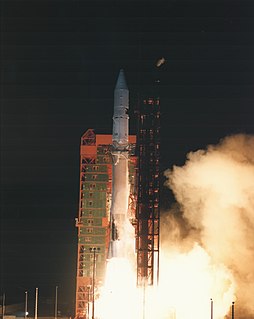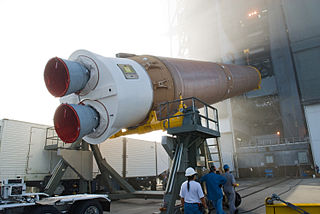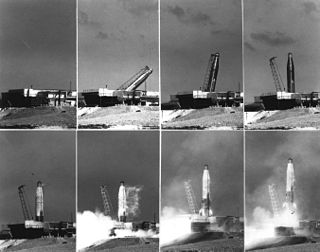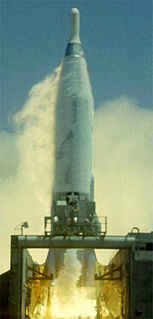 W
WAtlas is a family of US missiles and space launch vehicles that originated with the SM-65 Atlas. The Atlas intercontinental ballistic missile (ICBM) program was initiated in the late 1950s under the Convair Division of General Dynamics. Atlas was a liquid propellant rocket burning RP-1 fuel with liquid oxygen in three engines configured in an unusual "stage-and-a-half" or "parallel staging" design: two outboard booster engines were jettisoned along with supporting structures during ascent, while the center sustainer engine, propellant tanks and other structural elements remained connected through propellant depletion and engine shutdown.
 W
WThe Atlas G, also known as Atlas G Centaur-D1AR was an American expendable launch system derived from the Atlas-Centaur. It was a member of the Atlas family of rockets, and was used to launch seven communication satellites during the mid to late 1980s. Atlas G consisted of an improved Atlas core with modernized avionics and stretched propellant tanks. The Centaur stage also had several updated components and other technical improvements. It was replaced by the Atlas I, which had an improved guidance system.
 W
WThe Atlas H was an American expendable launch system derived from the SM-65 Atlas missile. It was a member of the Atlas family of rockets, and was used to launch five clusters of NOSS satellites for the US National Reconnaissance Office. Two flights also carried LiPS satellites, as secondary payloads for the United States Naval Research Laboratory.
 W
WThe Atlas I was a US expendable launch system manufactured by General Dynamics in the 1990s to launch a variety of satellites. The "I" in "Atlas I" can cause confusion, as all previous Atlas rockets were designated using letters, ending with the Atlas H, however subsequent rockets were designated using Roman numerals, starting with the Atlas II. Officially, the "I" is the Roman numeral "1". Eleven launches took place, with three failures.
 W
WAtlas II was a member of the Atlas family of launch vehicles, which evolved from the successful Atlas missile program of the 1950s. It was designed to launch payloads into low earth orbit, geosynchronous transfer orbit or geosynchronous orbit. Sixty-three launches of the Atlas II, IIA and IIAS models were carried out between 1991 and 2004; all sixty-three launches were successes, making the Atlas II the most reliable launch system in history. The Atlas line was continued by the Atlas III, used between 2000 and 2005, and the Atlas V which is still in use.
 W
WThe Atlas III was an American orbital launch vehicle, used in the years between 2000 and 2005. It was the first member of the Atlas family since the Atlas A to feature a "normal" staging method, compared to the previous Atlas family members, which were equipped with two jettisonable outboard engines on the first (booster) stage.
 W
WThe Atlas LV-3B, Atlas D Mercury Launch Vehicle or Mercury-Atlas Launch Vehicle, was a human-rated expendable launch system used as part of the United States Project Mercury to send astronauts into low Earth orbit. Manufactured by Convair, it was derived from the SM-65D Atlas missile, and was a member of the Atlas family of rockets. With the Atlas having been originally designed as a weapon system, testing and design changes were made to the missile to make it a safe and reliable launch vehicle. After the changes were made and approved to, the US launched the LV-3B nine times, four of which had crewed Mercury spacecraft.
 W
WAtlas V is an expendable launch system and the fifth major version in the Atlas rocket family. It was originally designed by Lockheed Martin, now being operated by United Launch Alliance (ULA), a joint venture between Lockheed Martin and Boeing. Atlas V is also a major NASA launch vehicle. In August 2021, ULA announced that Atlas V would be retired, and all 29 remaining launches had been sold. As of 5 October 2021, 28 launches remain.
 W
WVulcan Centaur is a two-stage-to-orbit, heavy-lift launch vehicle that is under development by the United Launch Alliance (ULA) since 2014 with an initial flight expected in 2022. It is principally designed to meet launch demands for the U.S. government's National Security Space Launch (NSSL) program for use by the United States Space Force and U.S. intelligence agencies for national security satellite launches. The maiden flight, planned for 2022, is slated to launch Astrobotic Technology's Peregrine lunar lander for NASA's Commercial Lunar Payload Services (CLPS) program.
 W
WThe Atlas-Able was an American expendable launch system derived from the SM-65 Atlas missile. It was a member of the Atlas family of rockets, and was used to launch several Pioneer spacecraft towards the Moon. Of the five Atlas-Able rockets built, two failed during static firings, and the other three failed to reach orbit.
 W
WThe Atlas-Agena was an American expendable launch system derived from the SM-65 Atlas missile. It was a member of the Atlas family of rockets, and was launched 109 times between 1960 and 1978. It was used to launch the first five Mariner uncrewed probes to the planets Venus and Mars, and the Ranger and Lunar Orbiter uncrewed probes to the Moon. The upper stage was also used as an uncrewed orbital target vehicle for the Gemini crewed spacecraft to practice rendezvous and docking. However, the launch vehicle family was originally developed for the Air Force and most of its launches were classified DoD payloads.
 W
WThe Atlas-Centaur was a United States expendable launch vehicle derived from the SM-65 Atlas D missile. Launches were conducted from Launch Complex 36 at the Cape Canaveral Air Force Station (CCAFS) in Florida.
 W
WThe Common Core Booster (CCB) is an American rocket stage, which is used as the first stage of the Atlas V rocket as part of its modular design. It was also intended that two additional CCBs would be used as boosters on the Atlas V Heavy, however this configuration has not been developed. Use of a Common Core Booster as the first stage of the Japanese GX was also planned; however, this program was cancelled in late 2009.
 W
WGX was a design for an expendable launch system intended to compete in the commercial satellite launch sector. The system had developed by Galaxy Express Corporation, a joint venture between IHI Corporation (IHI), the Japan Aerospace Exploration Agency (JAXA), United Launch Alliance (ULA), Lockheed Martin Corporation (LM) and several other Japanese companies.
 W
WThe RTV-A-2 Hiroc was a product of the United States' first effort to develop an intercontinental ballistic missile (ICBM). The project was named MX-774. The project was canceled in 1947, but leftover funds were used to build and launch three of the planned 10 research vehicles designated RTV-A-2. The design included several innovations; the gimbaled thrust chambers provided guidance control, the internal gas pressure was used to support the airframe and the nose cap was separable. All of these concepts were later used on the Atlas missile and the first two on the Viking (rocket). Also developed as part of MX-774 was the Azusa guidance system which was not used on the Hiroc missile but did contribute to the Atlas missile as well as many other early guided missiles launched from Cape Canveral.
 W
WAtlas is a family of US missiles and space launch vehicles that originated with the SM-65 Atlas. The Atlas intercontinental ballistic missile (ICBM) program was initiated in the late 1950s under the Convair Division of General Dynamics. Atlas was a liquid propellant rocket burning RP-1 fuel with liquid oxygen in three engines configured in an unusual "stage-and-a-half" or "parallel staging" design: two outboard booster engines were jettisoned along with supporting structures during ascent, while the center sustainer engine, propellant tanks and other structural elements remained connected through propellant depletion and engine shutdown.
 W
WThe Convair SM-65A Atlas, or Atlas A was the first full-scale prototype of the Atlas missile, which first flew on 11 June 1957. Unlike later versions of the Atlas missile, the Atlas A did not feature the stage and a half design. Instead, the booster engines were fixed in place, and the sustainer engine was omitted. The propulsion system used on the initial Atlas As was an early version of the Rocketdyne MA-1 engines with conical thrust chambers that produced a mere 135,000 pounds of thrust, compared with the 360,000 pounds of the fully operational Atlas D. Several pieces of hardware found on the operational Atlas were either missing on the A-series or only partially implemented. Powered flight on the A-series would last about two minutes and compared to later Atlases, long pad hold-down times, with up to 11 seconds between engine start and launcher release.
 W
WThe Convair SM-65B Atlas, or Atlas B, also designated X-12 was a prototype of the Atlas missile. First flown on 19 July 1958, the Atlas B was the first version of the Atlas rocket to use the stage and a half design with an operational sustainer engine and jettisonable booster engine section. Unlike later Atlas models, the Atlas B used explosive bolts to jettison the booster section.
 W
WThe SM-65C Atlas, or Atlas C was a prototype of the Atlas missile. First flown on 24 December 1958, the Atlas C was the final development version of the Atlas rocket, prior to the operational Atlas D. It was originally planned to be used as the first stage of the Atlas-Able rocket, but following an explosion during a static test on 24 September 1959, this was abandoned in favor of the Atlas D. Atlas C was similar to Atlas B, but had a larger LOX tank and smaller RP-1 tank due to technical changes to the Rocketdyne engines. Improvements in materials and manufacturing processes also resulted in lighter-weight components than the Atlas A and B. Booster burn time was much longer than the A/B series, up to 151 seconds. All launches took place from LC-12 at CCAS.
 W
WThe SM-65D Atlas, or Atlas D, was the first operational version of the U.S. Atlas missile. Atlas D was first used as an intercontinental ballistic missile (ICBM) to deliver a nuclear weapon payload on a suborbital trajectory. It was later developed as a launch vehicle to carry a payload to low Earth orbit on its own, and later to geosynchronous orbit, to the Moon, Venus, or Mars with the Agena or Centaur upper stage.
 W
WThe SM-65E Atlas, or Atlas-E, was an operational variant of the Atlas missile. It first flew on October 11, 1960, and was deployed as an operational ICBM from September 1961 until April 1966. Following retirement as an ICBM, the Atlas-E, along with the Atlas-F, was refurbished for orbital launches as the Atlas E/F. The last Atlas E/F launch was conducted on March 24, 1995, using a rocket which had originally been built as an Atlas E.
 W
WThe SM-65F Atlas, or Atlas-F, was the final operational variant of the Atlas missile, only differing from the Atlas E in the launch facility and guidance package used. It first flew on 8 August 1961, and was deployed as an operational ICBM between 1961 and 1966. Following retirement as an ICBM, the Atlas-F, along with the Atlas-E, was refurbished for orbital launches as the Atlas E/F.